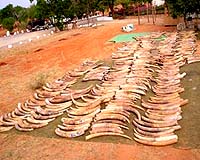| . |  |
. |
Manila (AFP) May 20, 2009 A deadly frog fungus that has wiped out hundreds of amphibian species in the Americas is now devastating the populations of five frog species in the Philippines, experts said Wednesday. A two-year nationwide survey by a team of US and Filipino scientists found that the Philippines has become the third country in Asia to be hit by the chytrid fungus. The fungus, which attacks the skin of frogs and salamanders and affects the formation of tadpoles' body parts, is also present in Japan and Indonesia. The Luzon striped frog, Rana similis, one of five affected endemic species, has practically disappeared from the lowland forests of Mount Labo on the southeast tip of the main Philippine island of Luzon, said Arvin Diesmos, curator of amphibians and reptiles at the National Museum of the Philippines. The Luzon stream frog (Rana luzonensis), two species of the Luzon fanged frog (Limnonectes woodworth and Limnonectes macrocephalus), and the Puddle frog (Occidozyga laevis) were also found to be infected in Labo and the Palay-palay mountain range near Manila. The nocturnal, stream-dwelling frogs form part of the diet of Philippine fauna, many of them threatened with extinction. "This is a very serious threat to amphibian biodiversity in the Philippines," said Rafe Brown, Diesmos' counterpart at the University of Kansas Biodiversity Institute and a member of the study team. "The Philippines is home to an incredibly diverse amphibian fauna. Along with forest destruction, pollution, and climate change, chytrid fungus may turn out to be the 'final blow' that sparks major amphibian extinctions in the archipelago," he added. He said the team that took part in the study suspects all of these factors could be linked to the spread of the fungus. At least 592 of the country's 1,137 endemic species of amphibians, birds and mammals are either threatened or endangered, according to the environment and natural resources department. The Philippines has about 110 species of frogs, 80 percent of them endemic to the country, Diesmos said. The naturally-occurring chytrid fungus has been linked to "hundreds" of amphibian extinctions in Europe, Australia and the Americas, according to Brown. Share This Article With Planet Earth
Related Links Darwin Today At TerraDaily.com
 Philippines seizes elephant tusk shipment from Tanzania
Philippines seizes elephant tusk shipment from TanzaniaManila (AFP) May 20, 2009 Philippine customs police have seized an illegal cargo of elephant tusks shipped from Tanzania, the government said Wednesday. The cargo, which was offloaded at the port of Manila, was fraudulently declared as a blow-moulding machine but customs inspectors instead found 98 sacks of plastics scraps, prompting them to hold the container and make a full check of its contents. They later fou ... read more |
|
| The content herein, unless otherwise known to be public domain, are Copyright 1995-2009 - SpaceDaily. AFP and UPI Wire Stories are copyright Agence France-Presse and United Press International. ESA Portal Reports are copyright European Space Agency. All NASA sourced material is public domain. Additional copyrights may apply in whole or part to other bona fide parties. Advertising does not imply endorsement,agreement or approval of any opinions, statements or information provided by SpaceDaily on any Web page published or hosted by SpaceDaily. Privacy Statement |